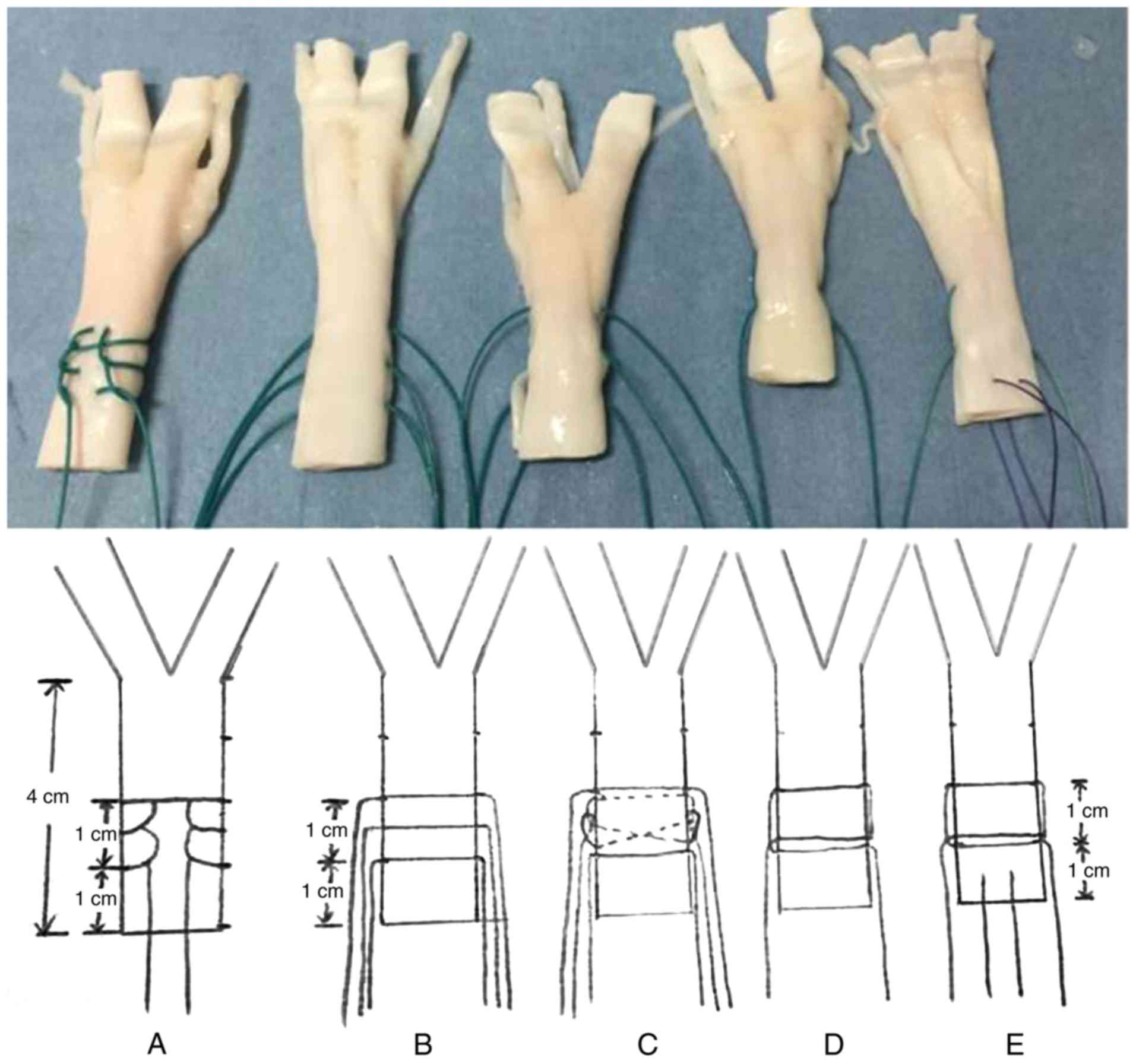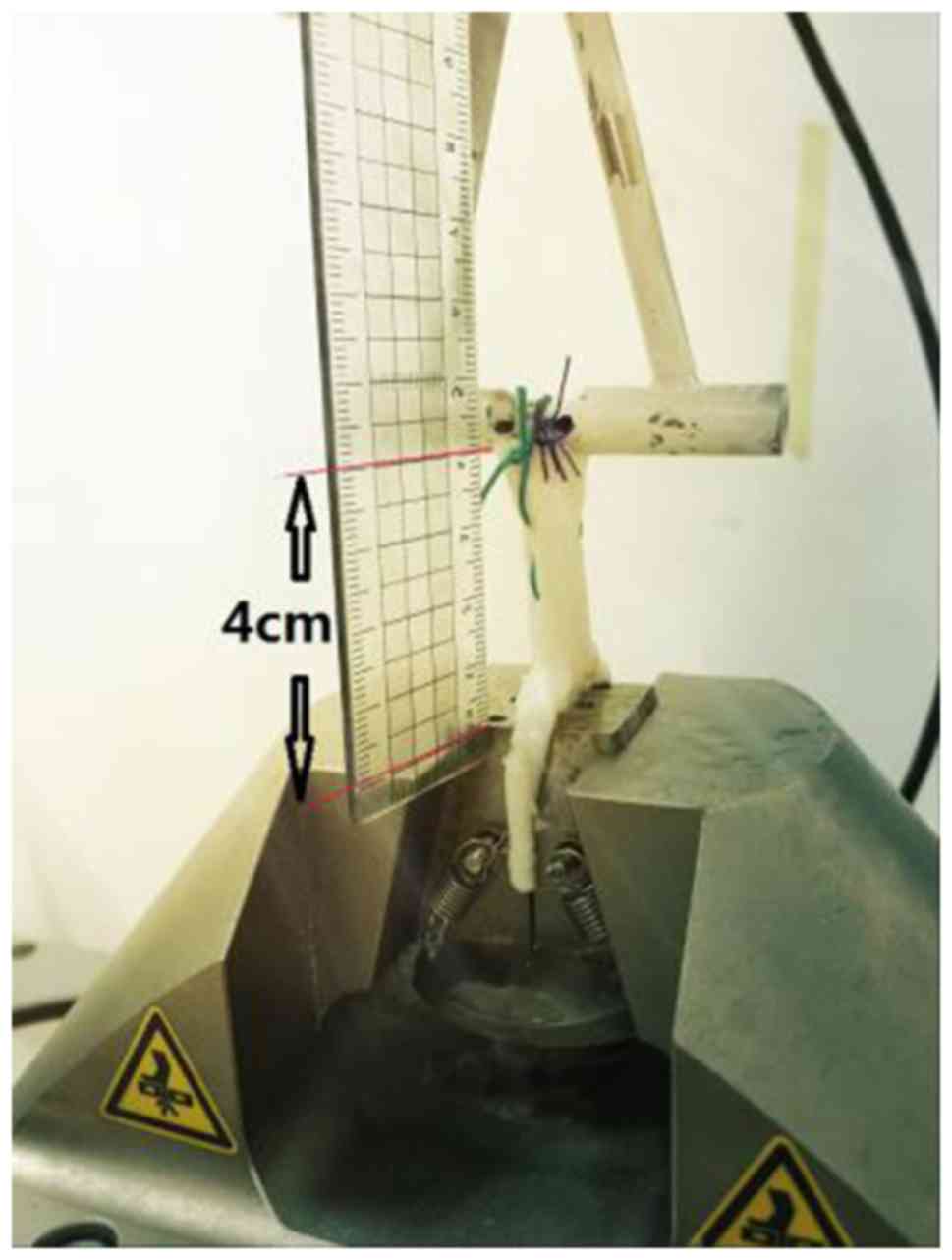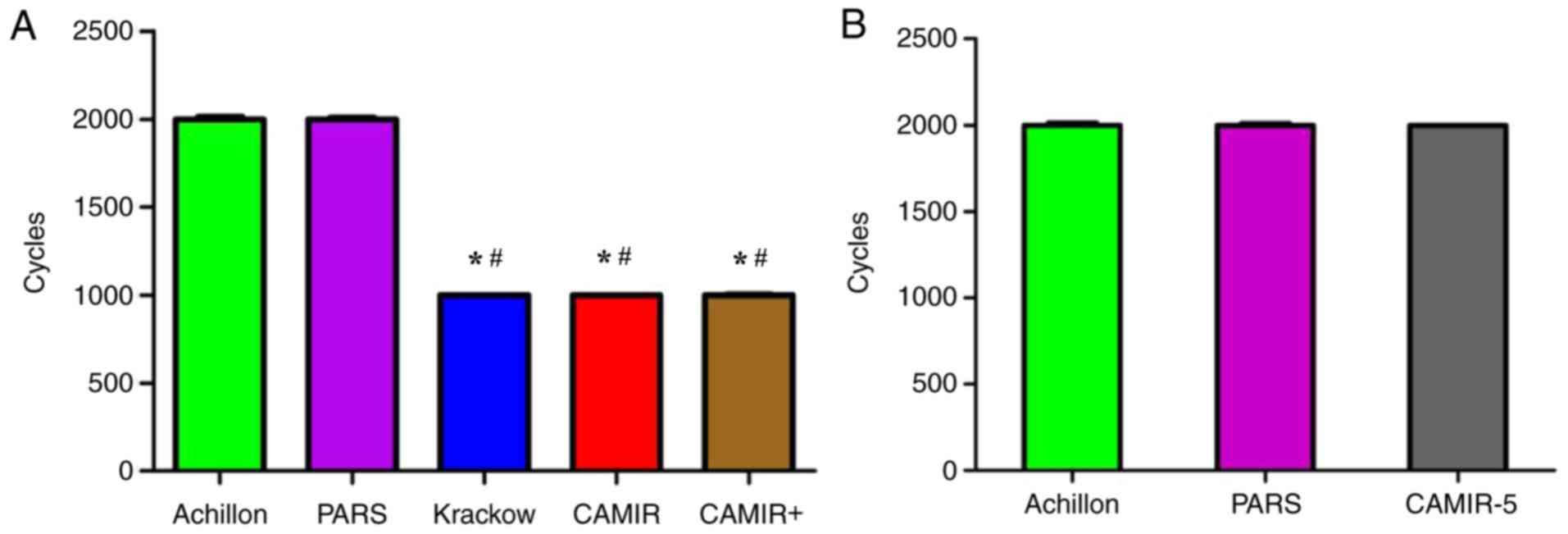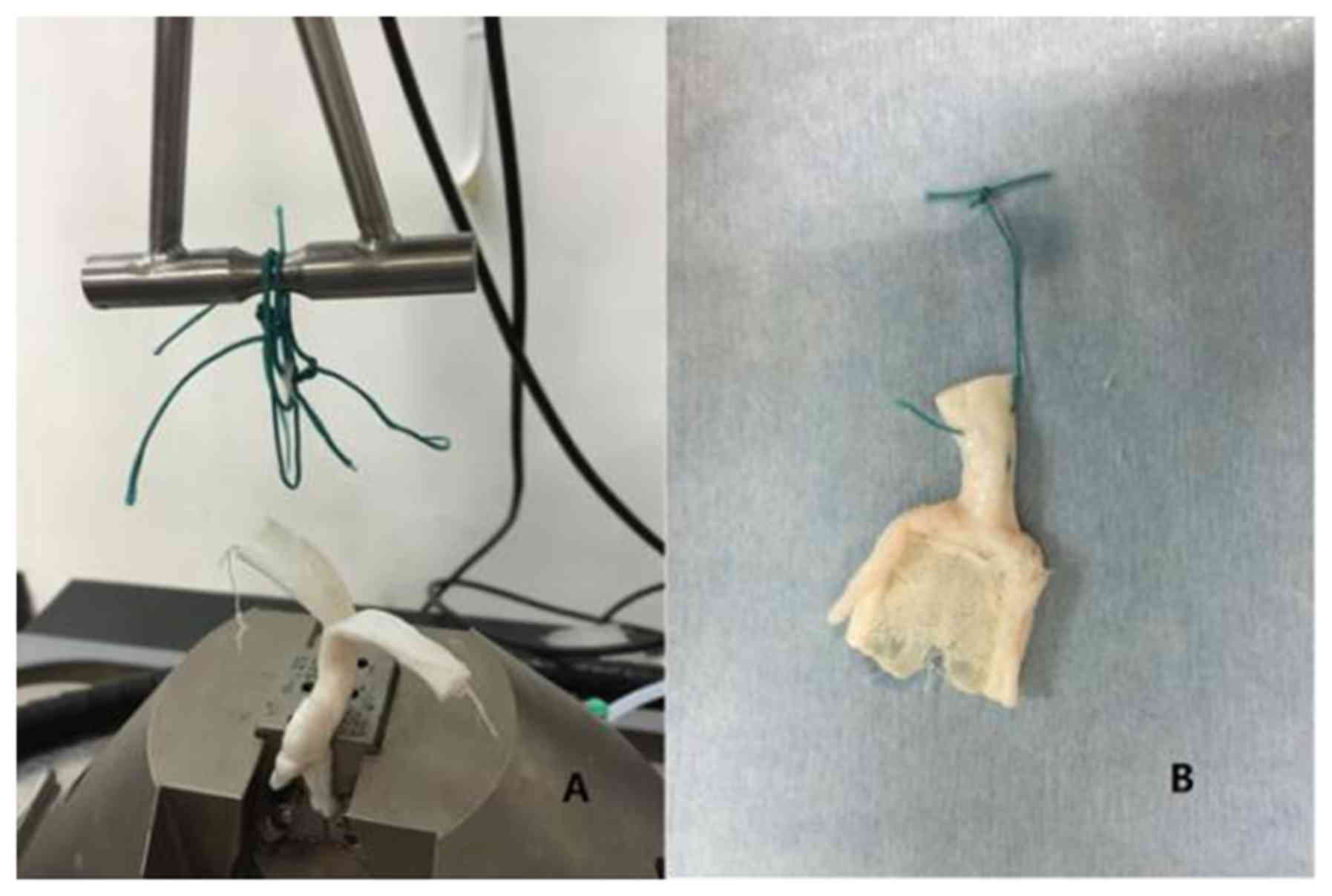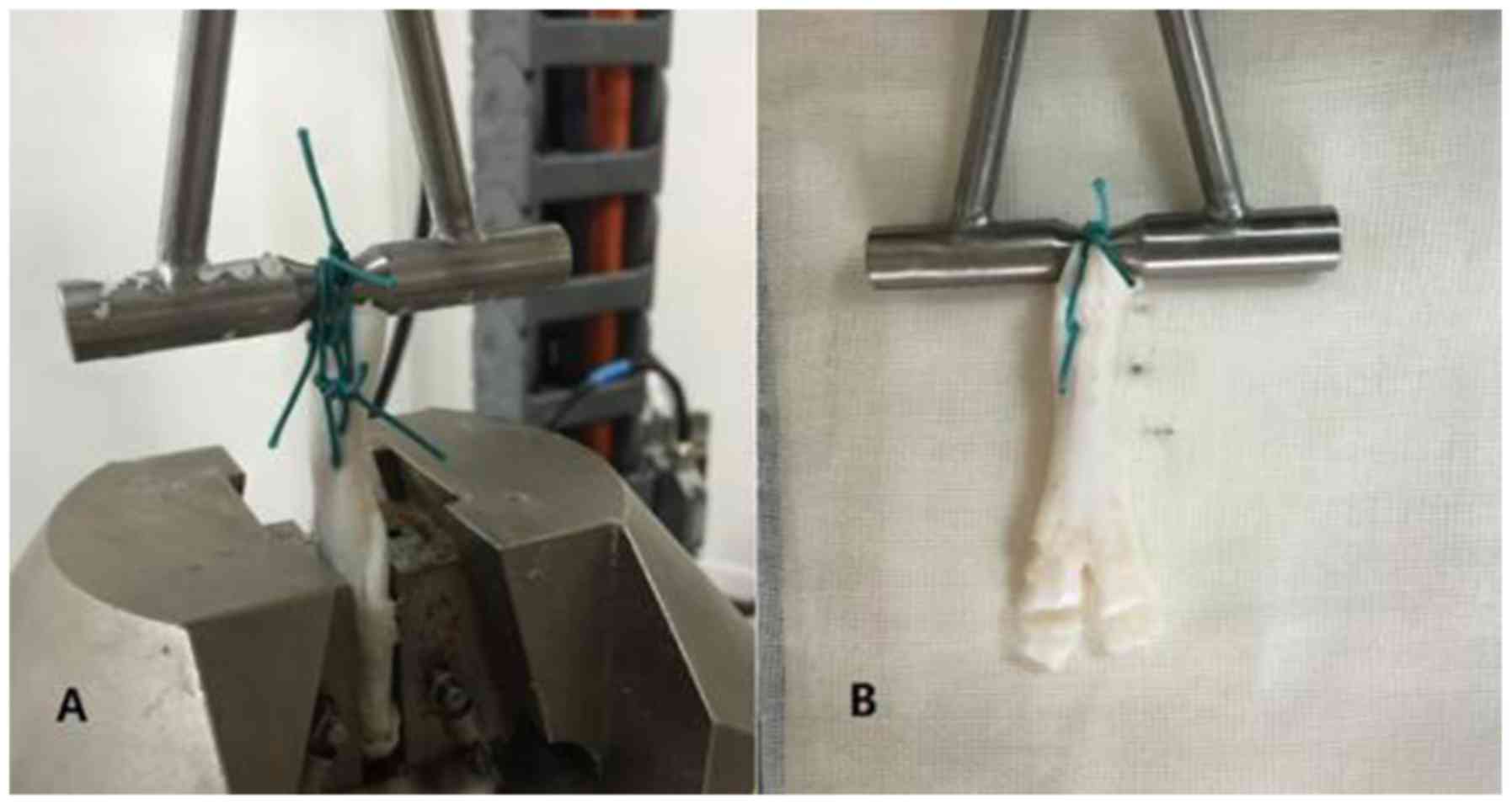|
1
|
Jozsa L, Kvist M, Balint BJ, Reffy A,
Järvinen M, Lehto M and Barzo M: The role of recreational sport
activity in Achilles tendon rupture. A clinical, pathoanatomical,
and sociological study of 292 cases. Am J Sports Med. 17:338–343.
1989. View Article : Google Scholar : PubMed/NCBI
|
|
2
|
Ganestam A, Kallemose T, Troelsen A and
Barfod KW: Increasing incidence of acute Achilles tendon rupture
and a noticeable decline in surgical treatment from 1994 to 2013. A
nationwide registry study of 33,160 patients. Knee Surg Sports
Traumatol Arthrosc. 24:3730–3737. 2016. View Article : Google Scholar : PubMed/NCBI
|
|
3
|
Khan RJ, Fick D, Keogh A, Crawford J,
Brammar T and Parker M: Treatment of acute achilles tendon
ruptures. A meta-analysis of randomized, controlled trials. J Bone
Joint Surg Am. 87:2202–2210. 2005. View Article : Google Scholar : PubMed/NCBI
|
|
4
|
Wilkins R and Bisson LJ: Operative versus
nonoperative management of acute Achilles tendon ruptures: A
quantitative systematic review of randomized controlled trials. Am
J Sports Med. 40:2154–2160. 2012. View Article : Google Scholar : PubMed/NCBI
|
|
5
|
Deng S, Sun Z, Zhang C, Chen G and Li J:
Surgical treatment versus conservative management for acute
Achilles tendon rupture: A systematic review and meta-analysis of
randomized controlled trials. J Foot Ankle Surg. 56:1236–1243.
2017. View Article : Google Scholar : PubMed/NCBI
|
|
6
|
Soroceanu A, Sidhwa F, Aarabi S, Kaufman A
and Glazebrook M: Surgical versus nonsurgical treatment of acute
Achilles tendon rupture: A meta-analysis of randomized trials. J
Bone Joint Surg Am. 94:2136–2143. 2012. View Article : Google Scholar : PubMed/NCBI
|
|
7
|
Hattrup SJ and Johnson KA: A review of
ruptures of the Achilles tendon. Foot Ankle. 6:34–38. 1985.
View Article : Google Scholar : PubMed/NCBI
|
|
8
|
Del Buono A, Volpin A and Maffulli N:
Minimally invasive versus open surgery for acute Achilles tendon
rupture: A systematic review. Br Med Bull. 109:45–54. 2014.
View Article : Google Scholar : PubMed/NCBI
|
|
9
|
Li Q, Wang C, Huo Y, Jia Z and Wang X:
Minimally invasive versus open surgery for acute Achilles tendon
rupture: A systematic review of overlapping meta-analyses. J Orthop
Surg Res. 11:652016. View Article : Google Scholar : PubMed/NCBI
|
|
10
|
Lee SJ, Sileo MJ, Kremenic IJ, Orishimo K,
Ben-Avi S, Nicholas SJ and McHugh M: Cyclic loading of 3 Achilles
tendon repairs simulating early postoperative forces. Am J Sports
Med. 37:786–790. 2009. View Article : Google Scholar : PubMed/NCBI
|
|
11
|
Aibinder WR, Patel A, Arnouk J, El-Gendi
H, Korshunov Y, Mitgang J and Uribe J: The rate of sural nerve
violation using the Achillon device: A cadaveric study. Foot Ankle
Int. 34:870–875. 2013. View Article : Google Scholar : PubMed/NCBI
|
|
12
|
Carmont MR and Maffulli N: Modified
percutaneous repair of ruptured Achilles tendon. Knee Surg Sports
Traumatol Arthrosc. 16:199–203. 2008. View Article : Google Scholar : PubMed/NCBI
|
|
13
|
Maffulli N, Longo UG, Maffulli GD, Khanna
A and Denaro V: Achilles tendon ruptures in elite athletes. Foot
Ankle Int. 32:9–15. 2011. View Article : Google Scholar : PubMed/NCBI
|
|
14
|
Maffulli N, Longo UG, Ronga M, Khanna A
and Denaro V: Favorable outcome of percutaneous repair of Achilles
tendon ruptures in the elderly. Clin Orthop Relat Res.
468:1039–1046. 2010. View Article : Google Scholar : PubMed/NCBI
|
|
15
|
Chen H, Ji X and Tang P, Liang X and Tang
P: Channel-assisted minimally invasive repair of acute Achilles
tendon rupture. J Orthop Surg Res. 10:1672015. View Article : Google Scholar : PubMed/NCBI
|
|
16
|
Krackow KA, Thomas SC and Jones LC: A new
stitch for ligament-tendon fixation. Brief note. J Bone Joint Surg
Am. 68:764–766. 1986. View Article : Google Scholar : PubMed/NCBI
|
|
17
|
Calder JD and Saxby TS: Early, active
rehabilitation following mini-open repair of Achilles tendon
rupture: A prospective study. Br J Sports Med. 39:857–859. 2005.
View Article : Google Scholar : PubMed/NCBI
|
|
18
|
Assal M, Jung M, Stern R, Rippstein P,
Rippstein P, Delmi M and Hoffmeyer P: Limited open repair of
Achilles tendon ruptures: A technique with a new instrument and
findings of a prospective multicenter study. J Bone Joint Surg Am.
84-A:161–170. 2002. View Article : Google Scholar : PubMed/NCBI
|
|
19
|
McKeon BP, Heming JF, Fulkerson J and
Langeland R: The Krackow stitch: A biomechanical evaluation of
changing the number of loops versus the number of sutures.
Arthroscopy. 22:33–37. 2006. View Article : Google Scholar : PubMed/NCBI
|
|
20
|
Ostrander RV, Saper MG and Juelson TJ: A
biomechanical comparison of modified krackow and locking loop
suture patterns for soft-tissue graft fixation. Arthroscopy.
32:1384–1388. 2016. View Article : Google Scholar : PubMed/NCBI
|
|
21
|
Hapa O, Erduran M, Havitçioğlu H, Çeçen B,
Akşahin E, Güler S and Atalay K: Strength of different Krackow
stitch configurations using high-strength Suture. J Foot Ankle
Surg. 52:448–450. 2013. View Article : Google Scholar : PubMed/NCBI
|
|
22
|
Orishimo KF, Burstein G, Mullaney MJ,
Kremenic IJ, Nesse M, McHugh MP and Lee SJ: Effect of knee flexion
angle on Achilles tendon force during passive dorsiflexion. J Foot
Ankle Surg. 47:34–39. 2008. View Article : Google Scholar : PubMed/NCBI
|
|
23
|
Akizuki KH, Gartman EJ, Nisonson B,
Ben-Avi S and McHugh MP: The relative stress on the Achilles tendon
during ambulation in an ankle immobilizer: Implications for
rehabilitation after Achilles tendon repair. Br J Sports Med.
35:329–334. 2001. View Article : Google Scholar : PubMed/NCBI
|
|
24
|
McMahon SE, Smith TO and Hing CB: A
meta-analysis of randomised controlled trials comparing
conventional to minimally invasive approaches for repair of an
Achilles tendon rupture. Foot Ankle Surg. 17:211–217. 2011.
View Article : Google Scholar : PubMed/NCBI
|
|
25
|
Cretnik A, Kosanovic M and Smrkolj V:
Percutaneous versus open repair of the ruptured Achilles tendon: A
comparative study. Am J Sports Med. 33:1369–1379. 2005. View Article : Google Scholar : PubMed/NCBI
|
|
26
|
Ebinesan AD, Sarai BS, Walley GD and
Maffulli N: Conservative, open or percutaneous repair for acute
rupture of the Achilles tendon. Disabil Rehabil. 30:1721–1725.
2008. View Article : Google Scholar : PubMed/NCBI
|
|
27
|
Cetti R, Christensen SE, Ejsted R, Jensen
NM and Jorgensen U: Operative versus nonoperative treatment of
Achilles tendon rupture. A prospective randomized study and review
of the literature. Am J Sports Med. 21:791–799. 1993. View Article : Google Scholar : PubMed/NCBI
|
|
28
|
Mark-Christensen T, Troelsen A, Kallemose
T and Barfod KW: Functional rehabilitation of patients with acute
Achilles tendon rupture: A meta-analysis of current evidence. Knee
Surg Sports Traumatol Arthrosc. 24:1852–1859. 2016. View Article : Google Scholar : PubMed/NCBI
|
|
29
|
Nilsson-Helander K, Silbernagel KG, Thomeé
R, Faxén E, Olsson N, Eriksson BI and Karlsson J: Acute Achilles
tendon rupture: A randomized, controlled study comparing surgical
and nonsurgical treatments using validated outcome measures. Am J
Sports Med. 38:2186–2193. 2010. View Article : Google Scholar : PubMed/NCBI
|
|
30
|
Brumann M, Baumbach SF, Mutschler W and
Polzer H: Accelerated rehabilitation following Achilles tendon
repair after acute rupture-Development of an evidence-based
treatment protocol. Injury. 45:1782–1790. 2014. View Article : Google Scholar : PubMed/NCBI
|
|
31
|
Clanton TO, Haytmanek CT, Williams BT,
Civitarese DM, Turnbull TL, Massey MB, Wijdicks CA and LaPrade RF:
A biomechanical comparison of an open repair and 3 minimally
invasive percutaneous Achilles tendon repair techniques during a
simulated, progressive rehabilitation protocol. Am J Sports Med.
43:1957–1964. 2015. View Article : Google Scholar : PubMed/NCBI
|
|
32
|
Demetracopoulos CA, Gilbert SL, Young E,
Baxter JR and Deland JT: Limited-open Achilles tendon repair using
locking sutures versus nonlocking sutures: An in vitro model. Foot
Ankle Int. 35:612–618. 2014. View Article : Google Scholar : PubMed/NCBI
|
|
33
|
Heitman DE, Ng K, Crivello KM and Gallina
J: Biomechanical comparison of the Achillon tendon repair system
and the Krackow locking loop technique. Foot Ankle Int. 32:879–887.
2011. View Article : Google Scholar : PubMed/NCBI
|
|
34
|
Benthien RA, Aronow MS, Doran-Diaz V,
Sullivan RJ, Naujoks R and Adams DJ: Cyclic loading of Achilles
tendon repairs: A comparison of polyester and polyblend suture.
Foot Ankle Int. 27:512–518. 2006. View Article : Google Scholar : PubMed/NCBI
|
|
35
|
Nichol SA and Silk WK: Empirical evidence
of a convection-diffusion model for pH patterns in the rhizospheres
of root tips. Plant Cell Environment. 24:967–974. 2001. View Article : Google Scholar
|
|
36
|
Cevik M: Acquired Umbilico-inguinal
fistula with persistent discharge due to suture reaction: A case
report and review of the literature. Case Rep Med. 2012:2163452012.
View Article : Google Scholar : PubMed/NCBI
|
|
37
|
Aktas S and Kocaoglu B: Open versus
minimal invasive repair with Achillon device. Foot Ankle Int.
30:391–397. 2009. View Article : Google Scholar : PubMed/NCBI
|
|
38
|
Casha JN and Hadden WA: Suture reaction
following skin closure with subcuticular polydioxanone in total
knee arthroplasty. J Arthroplasty. 11:859–861. 1996. View Article : Google Scholar : PubMed/NCBI
|
|
39
|
Kara A, Celik H, Seker A, Uysal MA, Uzun M
and Malkoc M: Granuloma formation secondary to Achilles tendon
repair with nonabsorbable suture. Int J Surg Case Rep. 5:720–722.
2014. View Article : Google Scholar : PubMed/NCBI
|



